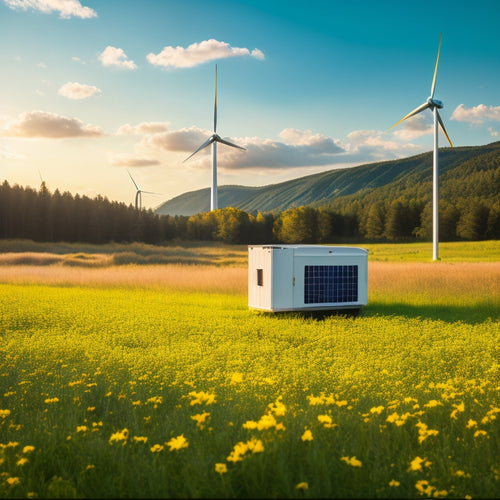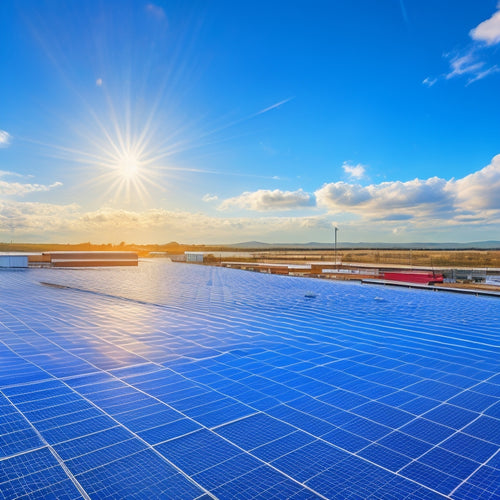
Achieve Carbon Footprint Reduction at Home in 3 Easy Steps
Share
To achieve carbon footprint reduction at home in 3 easy steps, start by upgrading to energy-efficient appliances, such as those with the ENERGY STAR label, which can greatly cut energy consumption. Next, optimize your energy usage by implementing simple strategies, like using natural lighting, turning off unused electronics, and sealing air leaks. Finally, consider investing in smart thermostat features like energy-saving modes, remote temperature control, and geofencing to automate your energy usage and save up to 20% energy. By exploring these options further, you can reveal a world of sustainable living possibilities and make a lasting impact.
At a Glance
- Evaluate appliances and upgrade to ENERGY STAR models to significantly cut energy consumption and reduce carbon footprint.
- Implement simple energy-saving tips, like utilizing natural lighting and turning off unused electronics, to minimize energy waste.
- Install smart thermostats with energy-saving modes and remote temperature control to optimize heating and cooling for lower utility bills.
- Seal air leaks, add insulation, and incorporate renewable resources like solar panels to enhance overall energy efficiency and reduce fossil fuel reliance.
- Monitor energy consumption patterns and make behavioral changes to optimize daily habits and decrease energy waste.
Energy-Efficient Appliances Matter
When you're looking to reduce your carbon footprint at home, it's important to evaluate the impact of your appliances.
You can start by incorporating smart home devices that help you monitor and control your energy usage, making it easier to identify areas for improvement.
Incorporating appliances with energy-efficient technologies, such as those found in high-efficiency solar cells, and upgrading old appliances to energy-efficient models, such as those with the ENERGY STAR label, can greatly cut your energy consumption.
Additionally, upgrading old appliances to energy-efficient models, such as those with the ENERGY STAR label, can greatly cut your energy consumption.
Smart Home Devices
Nearly every household has numerous devices and appliances that consume energy, with many being used on a daily basis. To reduce your carbon footprint, you can integrate smart home devices into your daily life.
Smart lighting systems, for instance, can markedly lower your energy consumption. These systems allow you to control the lighting in your home remotely, turning off lights when not in use. You can also automate the lighting schedule to adjust to your daily routine.
Another smart home device that can help reduce your carbon footprint is automated curtains. These curtains can be programmed to open and close during specific times of the day, taking advantage of natural light and heat. This not only reduces your energy consumption but also minimizes the strain on your heating and cooling systems.
Upgrade Old Appliances
Replacing old appliances with energy-efficient ones can considerably help you cut down on your carbon footprint. By upgrading to modern appliances, you'll not only reduce your energy consumption but also lower your utility bills.
When shopping for new appliances, look for products with high energy ratings, such as those with the ENERGY STAR label. This label indicates that the appliance has met energy efficiency standards set by the U.S. Environmental Protection Agency.
Another key factor to take into account is appliance lifespan. Energy-efficient appliances may have a higher upfront cost, but they can last longer than traditional appliances.
For example, an energy-efficient refrigerator can last up to 15 years, compared to a traditional one that may need to be replaced every 10 years. This longer lifespan means you'll need to replace appliances less often, reducing waste and the environmental impact of manufacturing new products.
Lowering Monthly Utility Bills
By implementing simple energy-saving tips and reducing energy consumption, you can greatly lower your monthly utility bills while decreasing your carbon footprint.
Start by optimizing your daily habits, such as turning off lights, electronics, and appliances when not in use, which can help minimize standby power consumption.
Additionally, shifting to solar energy can also contribute to a considerable reduction in carbon footprint, as a typical solar panel system saves up to 3 tons of CO2 over 25 years solar panel systems.
Moreover, integrating energy-efficient technology, such as solar panel and battery kits, can also play an essential role in reducing energy expenditure.
Simple Energy-Saving Tips
Taking a few simple steps can greatly reduce your energy consumption and lower your monthly utility bills.
Start by optimizing your home's lighting. During the day, make the most of natural lighting by keeping curtains and blinds open. This simple habit can considerably reduce your reliance on artificial lighting. When you do need to use artificial lighting, switch to energy-efficient options like LED bulbs or install smart lighting systems that can be controlled remotely.
Incorporate eco-friendly materials into your home's design to further reduce energy consumption. For example, use low-VOC (volatile organic compound) paints, sustainable wood for furniture, and recycled materials for insulation. These materials not only reduce energy consumption but also promote a healthier indoor environment.
Additionally, consider upgrading to energy-efficient appliances and electronics. Look for products with the ENERGY STAR label, which indicates that they meet energy efficiency standards set by the U.S. Environmental Protection Agency.
Reducing Energy Consumption
Your home's energy consumption can be markedly reduced through a combination of strategic upgrades and behavioral changes.
Start by scheduling an energy audit to identify areas of energy loss and opportunities for improvement. This audit will help you pinpoint where to focus your efforts, whether it's sealing air leaks with weather stripping, adding insulation to your attic and walls, or upgrading to energy efficient windows.
Consider incorporating passive design principles and renewable resources into your home.
Installing solar panels can greatly reduce your reliance on fossil fuels, while LED lighting can minimize energy waste.
Green building techniques and materials can also contribute to a more sustainable living space.
Smart Thermostat Features
You can reduce your energy consumption and lower your utility bills by leveraging smart thermostat features.
Two key features to look for in a smart thermostat are energy saving modes, which automatically adjust the temperature when you're not home or when you're sleeping, and remote temperature control, which allows you to adjust your home's temperature from your smartphone or tablet.
Additionally, you can optimize your overall energy usage by analyzing energy consumption patterns to identify areas for improvement and adjusting your thermostat accordingly.
Energy Saving Modes
As energy consumption patterns continue to evolve, smart thermostats have become essential tools for optimizing heating and cooling systems in homes. By embracing energy saving strategies, you can enjoy significant energy saving benefits that not only reduce your carbon footprint but also lower your utility bills.
To maximize energy efficiency, smart thermostats offer various energy saving modes. Here are some common modes and their benefits:
| Mode | Description | Benefits |
|---|---|---|
| Eco-Mode | Adjusts temperature settings to minimize energy consumption | Reduces energy usage by up to 20% |
| Sleep Mode | Automatically adjusts temperature settings when you're asleep or away | Saves up to 10% energy during sleeping hours |
| Vacation Mode | Maintains a constant temperature while you're away for an extended period | Saves up to 30% energy during prolonged absences |
| Geofencing Mode | Automatically adjusts temperature settings based on your location | Optimizes energy usage by up to 15% |
| Energy Star Mode | Optimizes energy consumption based on your energy usage patterns | Reduces energy usage by up to 25% |
Remote Temperature Control
Smart thermostats are taking home temperature control to the next level with remote temperature control capabilities. You can now adjust your home's temperature from anywhere, at any time, using your smartphone or tablet. This feature is particularly useful when you're away from home and want to guarantee you're not wasting energy by heating or cooling an empty house.
With remote access, you can turn up the heat or cool down your home just before you arrive, assuring a comfortable temperature when you walk in the door. This feature also allows you to monitor your energy usage in real-time, giving you essential understanding into your energy consumption patterns.
By adjusting your temperature scheduling remotely, you can optimize your energy usage and reduce your carbon footprint. You can set up temperature scheduling to automatically adjust the temperature when you're away or asleep, and even receive notifications when the temperature deviates from your set schedule.
This level of control and flexibility is a transformative factor for anyone looking to reduce their energy consumption and live a more sustainable lifestyle.
Smart Thermostat Compatibility Check
As you consider installing a smart thermostat to reduce your home's carbon footprint, it's crucial to check its compatibility with your existing HVAC system.
Consider evaluating the overall energy efficiency of your home, including appliances and lighting, to guarantee maximum energy savings. This evaluation can be done by conducting efficiency evaluations of your devices.
You'll want to review the thermostat's compatibility overview to confirm it works with your specific heating and cooling setup.
Before proceeding with the installation process, verify that the smart thermostat is compatible with your home's unique configuration.
Thermostat Compatibility Overview
Before installing a smart thermostat, it's crucial to ascertain compatibility with your home's heating, ventilation, and air conditioning (HVAC) system. This step will guarantee a seamless integration and peak performance of the device.
To begin, you'll need to identify your HVAC system's configuration, which typically includes a furnace, air conditioner, or heat pump.
Next, determine the type of thermostat you need, as there are several options available. The most common thermostat types include single-stage, two-stage, and multi-stage models, each designed for specific HVAC configurations.
Some thermostats may also require a common wire (C-wire) for power, while others can operate wirelessly.
When selecting a smart thermostat, consider the installation options available. Some models can be installed using existing wiring, while others may require additional wiring or a thermostat bridge.
Verify that your chosen thermostat is compatible with your HVAC system's communication protocols, such as Z-Wave or Zigbee.
Thermostat Installation Process
After verifying your smart thermostat's compatibility with your HVAC system, you're ready to proceed with the installation process. The installation process itself is relatively straightforward, regardless of the thermostat type you've chosen, such as a Wi-Fi enabled, learning, or geofencing thermostat.
Begin by turning off the power to your HVAC system at the circuit breaker or fuse box. Remove the faceplate of your old thermostat and take note of the wires connected to it. Compare the wiring configuration to the instructions provided with your new smart thermostat to ascertain a correct match.
Once you've connected the wires to the corresponding terminals on your new thermostat, you can mount it to the wall using the provided hardware. After powering on your HVAC system, test your new thermostat to verify it's communicating correctly with your heating and cooling system.
The installation benefits of a smart thermostat include increased energy efficiency, remote temperature control, and real-time energy usage tracking. By installing a smart thermostat, you'll be one step closer to reducing your carbon footprint and enjoying the freedom to control your energy usage on your terms.
Learning Curve Is Smaller
You'll find that concepts for reducing your carbon footprint at home are often easy to understand, even if you don't have a background in environmental science.
Simple changes, like switching to energy-efficient lighting or reducing water waste, can be implemented without extensive technical knowledge.
Easy to Understand Concepts
Reducing your carbon footprint at home can be achieved by implementing simple, easy-to-understand concepts that don't require extensive technical knowledge.
You can start by focusing on sustainable living practices that reduce your energy consumption and greenhouse gas emissions. For instance, you can switch to energy-efficient light bulbs and appliances, adjust your thermostat, and use power strips to eliminate standby power consumption.
In addition to these practical steps, you can also investigate carbon offset options to further reduce your carbon footprint.
Carbon offsets involve investing in projects that reduce greenhouse gas emissions, such as renewable energy projects or reforestation efforts. By purchasing carbon offsets, you can compensate for the emissions you can't avoid, making it easier to achieve a net-zero carbon footprint.
Frequently Asked Questions
What Is the Average Lifespan of a Smart Thermostat?
You'll find that a smart thermostat's average lifespan is around 10-15 years, but its benefits last a lifetime, helping you excel in energy saving techniques like remote temperature control and smart scheduling to reduce waste and save.
Can I Install a Smart Thermostat Myself?
You're standing at the crossroads of DIY independence, wondering if you can brave the thermostat installation wilderness. Yes, you can, but make certain your thermostat is compatible with your system to avoid a heating and cooling headache.
Are Energy-Efficient Appliances More Expensive Initially?
You'll likely face higher initial costs for energy-efficient appliances, but they often lead to long term savings through reduced energy consumption, lower utility bills, and extended lifespan, ultimately paying for themselves over time.
How Long Does It Take to See Utility Bill Savings?
When you upgrade to energy-efficient appliances, you'll start seeing utility bill savings within 1-3 months, depending on usage and savings factors, allowing you to break free from high energy costs and enjoy a lighter footprint.
Do Smart Thermostats Work With Older Homes?
Embracing the sweet song of energy efficiency, you'll find that smart thermostats can harmonize with older homes, offering compatibility with many existing systems, and revealing benefits like reduced energy waste and lower bills.
Explore More
By embracing these simple steps, you're planting a seed of sustainability that can bloom into a greener lifestyle. Every watt saved and every degree adjusted is a ripple in the ocean of environmental conservation. Your home is now a haven of eco-friendliness, where energy-efficient appliances hum in harmony with smart thermostats. The result? A reduced carbon footprint that not only eases your wallet but also the weight on the planet.
Related Posts
-

Sustainable and Eco-Friendly Generators for a Reduced Carbon Footprint
Sustainable and eco-friendly generators are perfect for cutting your carbon footprint and increasing energy efficienc...
-

Solar Powered Lights for Sustainable Home Decor
Solar-powered lights offer a stylish and eco-friendly way to enhance your home decor. They capture sunlight, converti...
-

Commercial Solar Energy
As you consider powering your business with commercial solar energy, you'll uncover it offers a triple benefit: signi...


